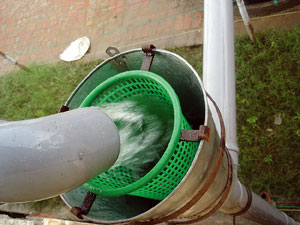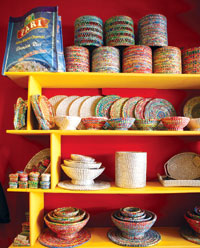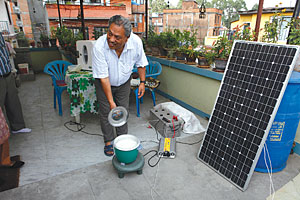 ONE SOLUTION |
Investing in rain
Over-exploited ground water, growing demand and bad management have led to severe water shortage in Kathmandu, which is only bound to get worse. Melamchi is a mirage, so collecting falling rain is the only way out.
The idea is simple: just collect rain that falls on your roof, channel it through to a coarse mesh to filter debris, through a sand bed and store it. Excess water can be channelled to recharge the water table.
Tyler McMahon and his team at Smart Paani have installed 40 rainwater harvesting systems in Kathmandu offices, hotels, schools and households this year alone. "The Valley receives most of its rain from June to September, but most of it is wasted and goes down the drains, what we do is collect for our customer's daily needs," explains McMahon.
Despite the system's potential to revolutionise the way we acquire water, people are deterred by the initial cost as well as unfounded fears about pollution. Raju Dangol, a rainwater harvesting technician, is puzzled by the resistance. He says: "I don't understand why Nepalis who spend thousands for tanker water are hesitant to invest on a long-lasting and effective system that will save them money. After all it's not that they have a choice."
Bhrikuti Rai
Smart Paani: 01-5521906
Read also:
Collecting rain
Sky water
Pretty plastic
 BIKRAM RAI |
We throw away used Wai Wai and Lay's packets, chocolate wrappers, rice sacks, and tyres. But at Jeevan Kala, people earn their livelihood recycling them into useful products.
Jeevan Kala is a part of Himalayan Health Care (HHC) and collects plastic waste and sends them to artisans in northern Dhading who use them to create beautiful eco-friendly handicrafts. With outlets in Thamel and New York, Jeevan Kala has generated Rs 50 million in the past 11 years selling bowls, waste paper baskets, purse, bags, camera holders and trinkets. The money goes for the upkeep of 18 schools and stipends for 40 orphans and underprivileged children in northern Dhading. HHC also trains health workers and nurses and organises regular health camps.
Explains Sony Parajuli of HHC: "Making money is not our goal, we want to impart income-earning skills so that poor families can become financially independent."
Stuti Sharma
Jeevan Kala: 01-5528139
Read also:
A model hospital
Out of sight is not out of mind
Papier-mache initiative
State of sunshine
 BIKRAM RAI |
Since demand has far outstripped supply, there will be power cuts this time even during the monsoon. It may be the right time to invest in solar panels on your roof for 24-hour electricity for lights and running computers in your homes and offices.
What has deterred most Nepalis is the cost. But the prices of photo-voltaic cells are coming down and there is a way to make solar affordable. Jagannath Shrestha, president of the Nepal Solar Energy Society says: "It's possible to keep costs at a minimum by using CFL and appliances with low wattage."
Shrestha practices what he preaches and uses solar cells to run kitchen appliances to reduce his dependence on LPG, kerosene and firewood. Even the rice cooker in his house is powered by two 85 watt solar panels, two batteries of 100 ampere and an inverter. Shrestha now plans to order low-power refrigerators which can also run on solar.
Shrestha doesn't see any reason why families that splurge on furniture and decoration should complain about the cost of solar panels. "It's not a luxury, solar has become a necessity," he explains, "these systems are very durable and once installed, customers can live hassle-free lives without worrying about load shedding, diesel or inverters."
Bhrikuti Rai
Read also:
Here comes the sun
Bring home the sunshine
Rabi rocks! (The sun god, that is)


